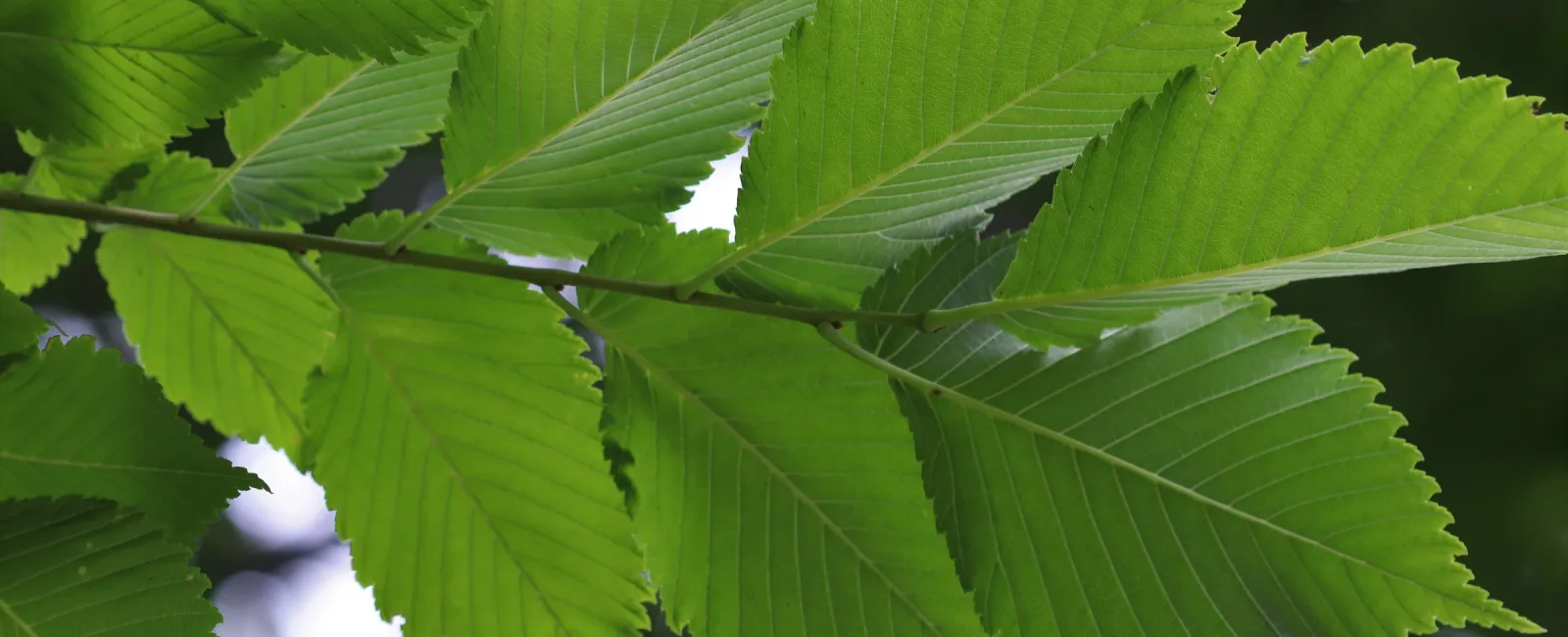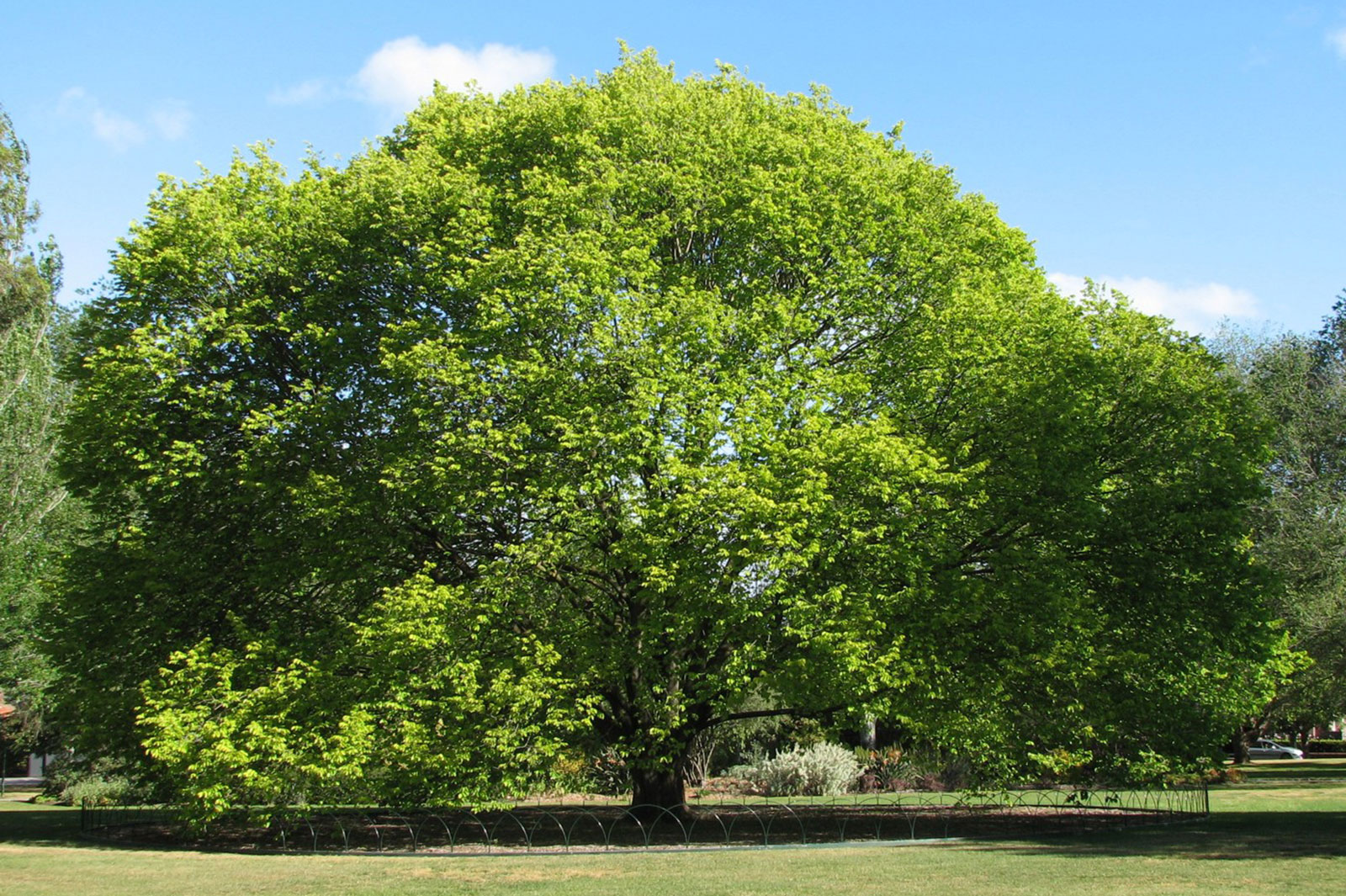
Identifying Elm Trees
Elm trees are graceful trees common to North America and Europe. With their iconic vase-shaped canopies and attractive fall color, elms are popular choices for landscaping and shade trees. Knowing how to identify an elm tree can help you appreciate and care for these trees. Here in Roswell, Alpharetta & Woodstock, GA, we see elm trees frequently and are one of the hardiest deciduous trees in the country!
What Does an Elm Tree Look Like?
Elm trees have a vase or fountain-shaped canopy that provides ample shade. They have an oval form and gracefully arching branches. Elm leaves are oval or elliptical in shape with serrated edges and unequal leaf bases. The leaves are arranged alternately on branches.
In spring, elm trees produce small clusters of inconspicuous flowers. The oval winged seeds mature in spring and often float to the ground. Elm bark starts out smooth and gray on young trees but becomes furrowed with age, resembling interlacing ropes on older trunks.

Types of Elm Trees
There are approximately 30-35 species of elm trees. Some common North American species include:
American elm – Once abundantly planted, this tree has been devastated by Dutch elm disease. It has a vase shape and gray furrowed bark. Leaves have coarse double teeth on margins.
Slippery elm – Named for its mucilaginous inner bark. It has a more pyramidal shape than other elms. Leaves are sandpapery above with rusty hairs below.
Siberian elm – A fast-growing but short-lived elm introduced from Asia. It has small rough leaves and invasive tendencies.
Rock elm – A large elm native to eastern North America. It has corky wings on branches and leaves with three main veins.
English elm – A popular landscape elm in Europe now threatened by Dutch elm disease. It has a spreading canopy and deeply furrowed bark.
Elm Tree Leaves
Examining the leaves is often the easiest way to identify elm trees. Elm leaves have distinctive asymmetric bases and coarse doubly serrate edges. The leaf surfaces may be smooth, sandpapery, or hairy depending on the species.
American Elm Leaves
American elm leaves are around 3 to 5 inches long with coarse sawtooth edges. The upper leaf surfaces have a sandpapery feel while the lower surfaces are smooth. Leaves turn bright yellow in the fall.
Slippery Elm Leaves
Slippery elm leaves are much like American elm leaves in size and shape. The upper surfaces have a rough texture while the lower surfaces are covered in coarse hairs. Fall foliage is dull yellow.
Siberian Elm Leaves
Siberian elm leaves are much smaller at around 2 inches long. The leaves are smooth and doubly serrated on the margins. Fall color is undistinguished yellow-green.
Rock Elm Leaves
Rock elm leaves reach 4 to 6 inches long. They have three conspicuous veins leading to the leaf tip. The deeply serrated edges have curved teeth tipped with small bristles.
Elm Tree Bark
Examining bark texture and pattern can also help identify elm species. With age, elm bark develops rough furrows and ridges forming rope-like patterns.
American Elm Bark
Mature American elm bark is ashy gray with broad, flat ridges separated by diamond-like furrows. Young bark starts out buff brown and smooth.
Slippery Elm Bark
Like American elms, slippery elms develop gray furrowed bark with age. But slippery elm bark has reddish layers when cut or damaged.
Siberian Elm Bark
Siberian elm bark starts smooth with vertical markings when young. Over time it becomes irregularly ridged and furrowed.
Rock Elm Bark
The bark of rock elm has a unique texture described as “warty” with many small corky projections. Underneath is an inner bark tinged with orange.
Identifying Elm Seeds
Elm seeds form in spring as flat papery discs called samaras. The seeds have a central nutlet orbited by a flattened oval wing. When they fall from their clusters, the wing catches air to carry the seed some distance from the parent tree.
American Elm Seeds
American elm seeds are about 3/4 inch across, circular, and smooth at the edges. They mature early and fall before the leaves emerge.
Siberian Elm Seeds
Siberian elm seeds look very similar to American elm seeds. They release earlier when only 1/2 inch long but reach a full inch across when mature later in spring.
English Elm Seeds
English elm seeds are up to an inch long, oval rather than round, and fringed with hairs along the edge of the wing
How to Plant and Care for Elm Trees
Elm trees bring beauty, shade, and ornate architecture to landscapes. But they require some care and pruning to thrive. Follow these tips to successfully plant and grow healthy elm trees.
Choosing a Site
When planting elm trees, pick a site with:
Full sun exposure
Well-drained soil
Plenty of room for the tree’s broad canopy
Avoid soggy areas or soils with poor drainage. Space trees at least 50 feet apart to prevent crowding as they mature.
Planting Elm Trees
The easiest way to plant an elm tree is in early spring or fall as a young container-grown specimen. Dig a hole twice as wide as the root ball and slightly shallower. Set the root ball on firm soil and backfill with the excavated dirt. Water thoroughly after planting.
Caring for Elm Trees
Here is a checklist for caring for elm trees:
Water deeply once a week during the first year
Apply a 2-4 inch layer of mulch around the base
Prune crossing or damaged branches
Monitor for signs of disease like Dutch elm disease
Fertilize every other year with a balanced organic fertilizer
Proper pruning for structure and safety is also important in caring for elm trees. Hire a professional arborist to assess and prune large mature trees.
Protecting Elm Trees from Disease
Dutch elm disease has devastated many of North America’s elm trees. Prevent infection by:
Pruning carefully with clean tools
Destroying and disposing of infected elm wood
Treating valuable landscape trees preventatively with fungicides
Planting disease-resistant elm cultivars
With proper site selection, planting, care, and disease prevention, elm trees make stunning landscape specimens for generations of beauty and enjoyment. Reach out to Caldwell Tree Care if you need help with your elm tree.
